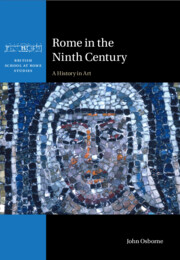Book contents
- Rome in the Ninth Century
- British School at Rome Studies
- Rome in the Ninth Century
- Copyright page
- Contents
- Figures
- Acknowledgements
- Abbreviations
- Ninth-century Popes
- 1 Introduction
- 2 Rome in 800: The Pontificate of Leo III
- 3 Paschal I, the Church of Santa Prassede and the Question of a ‘Carolingian Renovatio’ in Rome
- 4 Paschal I: Other Projects
- 5 Eugenius II, Gregory IV and Sergius II
- 6 The Gathering Storm: The Pontificate of Pope Leo IV (847–55)
- 7 Benedict III, Nicholas I and Hadrian II, and the Continuing ‘Greek’ Presence in Rome
- 8 The Last Hurrah: John VIII (872–82)
- 9 ‘Not with a Bang but a Whimper’
- Afterword
- Bibliography
- Index
1 - Introduction
Published online by Cambridge University Press: 10 October 2023
- Rome in the Ninth Century
- British School at Rome Studies
- Rome in the Ninth Century
- Copyright page
- Contents
- Figures
- Acknowledgements
- Abbreviations
- Ninth-century Popes
- 1 Introduction
- 2 Rome in 800: The Pontificate of Leo III
- 3 Paschal I, the Church of Santa Prassede and the Question of a ‘Carolingian Renovatio’ in Rome
- 4 Paschal I: Other Projects
- 5 Eugenius II, Gregory IV and Sergius II
- 6 The Gathering Storm: The Pontificate of Pope Leo IV (847–55)
- 7 Benedict III, Nicholas I and Hadrian II, and the Continuing ‘Greek’ Presence in Rome
- 8 The Last Hurrah: John VIII (872–82)
- 9 ‘Not with a Bang but a Whimper’
- Afterword
- Bibliography
- Index
Summary
The Introduction sets out the methodological approach of the book, and the major themes to be addressed. It is a ‘history in art’, a notion that provides for a primary focus on the evidence adduced from material culture (archaeology, standing remains and their decoration, surviving objects including manuscripts) integrated with information derived from written sources (in this instance primarily the series of papal biographies known as the Liber pontificalis, supplemented by other documents such as the Ordines Romani and the chronicles of Frankish and Italian historians). The two other overarching themes are the gradual decline of the Roman economy, and the resulting impoverishment of the Roman Church over the course of the ninth century and its effects on papal patronage, and the continuing adherence of Roman artistic production to the broader context of Mediterranean Christian visual culture. A historiographical survey/analysis is also included.
- Type
- Chapter
- Information
- Rome in the Ninth CenturyA History in Art, pp. 1 - 9Publisher: Cambridge University PressPrint publication year: 2023

